Despite the oppressive heat of the surrounding air, the delicate flowers of the yellow thistle plant exhibit remarkable resilience by maintaining a cool demeanor. This unique ability to endure extreme temperatures while preserving their composure serves as a testament to the adaptability and survival strategies employed by various plant species in challenging environments.
Resilient Characteristics of the Yellow Thistle
The yellow thistle, scientifically known as Cirsium horridulum, is a species of flowering plant native to North America, particularly prevalent in regions with hot and arid climates. Despite its prickly appearance and rugged demeanor, the yellow thistle possesses a surprising ability to thrive in adverse conditions, including soaring temperatures that would wilt less resilient vegetation.
The mechanism behind the yellow thistle’s ability to stay cool amidst sweltering air lies in its intricate biology and physiological adaptations. Like many desert-adapted plants, the yellow thistle employs strategies such as transpiration and evaporative cooling to regulate its internal temperature and prevent overheating. Through the process of transpiration, moisture is drawn from the plant’s roots and transported to its leaves, where it evaporates into the surrounding atmosphere, effectively dissipating heat and maintaining a cool microclimate around the plant.
Additionally, the yellow thistle’s unique leaf structure and surface properties play a crucial role in heat management. The plant’s leaves are often coated with a waxy cuticle, which helps to minimize water loss through evaporation and provides a protective barrier against excessive heat radiation. Furthermore, the presence of specialized cells called stomata allows the plant to control the exchange of gases, including water vapor, carbon dioxide, and oxygen, thereby regulating internal temperature and moisture levels.
In addition to its physiological adaptations, the yellow thistle’s ability to withstand extreme heat is also attributed to its deep-rooted resilience and efficient resource utilization. The plant’s extensive root system enables it to access water and nutrients from deep within the soil, allowing it to survive prolonged periods of drought and heat stress. Furthermore, the yellow thistle exhibits a remarkable capacity for efficient water use, optimizing its water uptake and retention to sustain itself in harsh environmental conditions.
Adaptive Insights from the Yellow Thistle Amid Climate Challenges
The resilience of the yellow thistle serves as a valuable reminder of the extraordinary adaptations and survival strategies employed by plants to thrive in challenging habitats. As temperatures continue to rise due to climate change and global warming, understanding the mechanisms that enable plants like the yellow thistle to withstand heat stress can provide valuable insights for conservation efforts and ecosystem management.
The ability of the yellow thistle’s flowers to remain cool despite the scorching air surrounding them is a testament to the plant’s remarkable resilience and adaptive capacity. By employing sophisticated physiological mechanisms and resource management strategies, the yellow thistle exemplifies nature’s ingenuity in coping with harsh environmental conditions and serves as a source of inspiration for ecological resilience and sustainability efforts.
